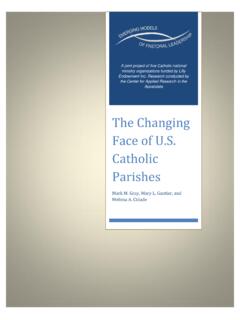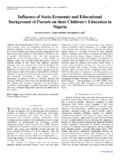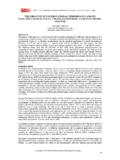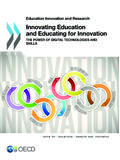Transcription of Demographic and Background Characteristics
1 15 Demographic and Background Characteristics This subsection summarizes Background Characteristics of respondents. Knowledge Networks has previously compiled a great deal of information on the Demographic Characteristics of its panel members. Demographic Characteristics include gender, generation, race and ethnicity, education, geographic region, and marital status. For these previously compiled factors, the tables show unweighted frequencies (the raw percentage of respondents to the survey) as well as weighted frequencies (percentages that have been statistically adjusted to compensate for higher or lower rates of participation in the survey among various Demographic groups in the panel).
2 9 This section also summarizes respondents Catholic schooling and the frequency with which they attend Mass. Several of these Demographic and Background Characteristics are used later in the report to draw comparisons among respondents for example to compare the responses of Catholics of different generations or different ethnicities. Comparisons on the basis of Mass attendance are presented consistently throughout the report. For all other Background Characteristics , comparisons are presented only when differences are statistically significant. Gender After weighting, 52 percent of the survey respondents are women and 48 percent are men. This greater proportion of women largely reflects higher mortality rates among men.
3 Gender Unweighted Weighted Female 51% 52% Male 49 48 9 After this subsection, the remainder of the report presents only weighted frequencies. 16 Generation The age of respondents ranges from 18 to 97, with a median of 47. Important differences among respondents are often found along generational lines. CARA divides Catholics into the following four generations, reflecting categories used by other researchers. The Pre-Vatican II Generation, ages 66 and over in 2008. The Pre-Vatican II Generation was born in 1942 or earlier.
4 Its members came of age before the Second Vatican Council. After weighting, members of the Pre-Vatican II Generation make up 17 percent of respondents to the survey. The Vatican II Generation, ages 48-65 in 2008. These are the baby boomers who were born between 1943 and 1960, a time of great Demographic and economic growth. They came of age during the time of the Second Vatican Council and their formative years likely spanned that time of profound changes in the Church. Vatican II Generation parishioners make up 33 percent of respondents. The Post-Vatican II Generation, ages 27-47 in 2008. Born between 1961 and 1981, this generation, sometimes called Generation X or baby busters by demographers, has no lived experience of the pre-Vatican II Church.
5 Thirty-six percent of respondents are members of the Post-Vatican II Generation. The Millennial Generation, ages 18-26 in 2008. This generation, born in 1982 or later (up to 1990 among adults), have come of age primarily under the papacies of John Paul II and Benedict XVI. Because some still live with their parents, their religious practice is often closely related to that of their families of origin. Fifteen percent of respondents belong to the Millennial Generation. Generation Unweighted Weighted10 Pre-Vatican II 20% 17% Vatican II 39 33 Post-Vatican II 30 36 Millennial 11 15 10 Whenever percentages in a table sum to 99 or 100 (as is the case in the second column), the reason is rounding error.
6 17 Adult Race and Ethnicity Because people of Hispanic/Latino(a) origin can be of any race, respondents are divided into those who self-identify as being of Hispanic origin and those who say they are members of each of three racial groups (white, African American, and other) but answer no to the Hispanic origin question. Race and Ethnicity Unweighted Weighted Non-Hispanic white 69% 64% Hispanic or Latino(a) 24 28 African American 2 3 Other11 5 5 After weighting, 64 percent of respondents are non-Hispanic whites. Twenty-eight percent are Hispanic or Latino(a).12 Three percent are African American, and five percent are members of other racial and ethnic groups.
7 Note that subgroup comparisons later in this report focus on two racial and ethnic groups: non-Hispanic whites and Hispanics. There are too few respondents of other racial and ethnic identities for separate comparison. 11 These categories represent Knowledge Networks summary classification for race and ethnicity. Other primarily consists of includes Asians, Pacific Islanders, and Native Americans as well as other racial and ethnic groups. 12 In CARA s most recent telephone poll in January 2007, the percentage of Catholics self-identifying as Hispanic or Latino was 35 percent (weighted).
8 On average, Knowledge Networks polls tend to underestimate the percentage of Catholics who are Hispanic/Latino by about 6 percentage points. CARA still prefers using Knowledge Networks rather than telephone polls for the significant reduction in social desirability bias that comes with using the self-administered format (see Appendix II). Across a variety of indicators, CARA has found that telephone polls dramatically over-estimate frequency of Mass attendance, frequency of giving, frequency of going to confession, evaluations of Church leaders, etc. The multiple benefits across many key questions of using the Knowledge Networks format far outweigh this single cost of slightly underestimating the Hispanic/Latino population.
9 Knowledge Networks likely underestimates the percentage of the Catholic population that is Hispanic/Latino due to panel members being recruited through landline telephones followed by eligibility requirements to join the panel that include the household having either a computer or television to complete the survey. CARA created a weight to bring up the percentage of Hispanics/Latinos in the poll to 35 percent from 28 percent. Differences in responses vary by about 1 percentage point or less for each question using this weight. This weighting represents the correct size of the Hispanic/Latino population among respondents, however it does not correct for the attributes of Hispanics/Latinos who are missed that may be related to a lack of telephone or television (or computer) as well as the ability to answer questions in English or Spanish in a text-based self-administered survey.
10 CARA has compared, and does compare in this report, the results of its telephone polls and Knowledge Networks polls. The distortions caused by telephone polling for questions regarding religious attitudes and behaviors (that are strongly affected by social desirability pressures) are significantly larger than those resulting from the underestimation of the Hispanic/Latino population in the Knowledge Networks panel. Frequencies for results using the weight that brings the Hispanic/Latino percentage among respondents to 35 percent are available upon request. 18 Education About one in six adult Catholics have not completed high school. About one-third have a high school diploma.











